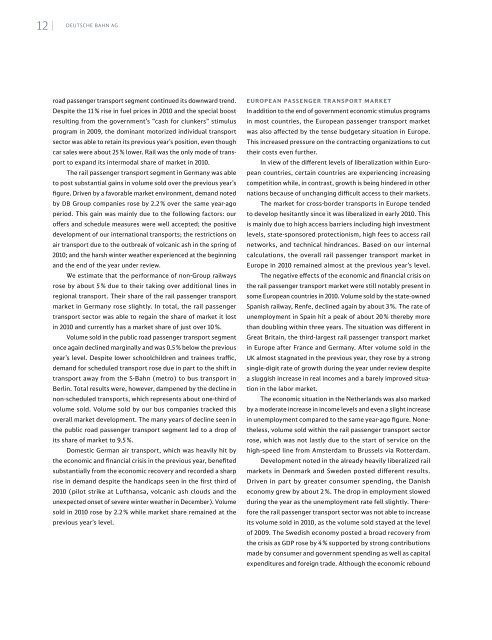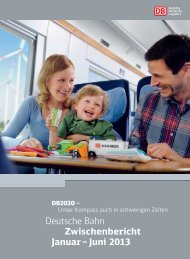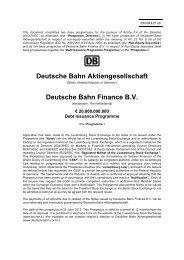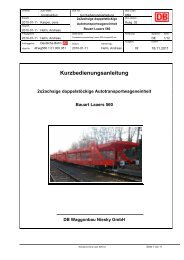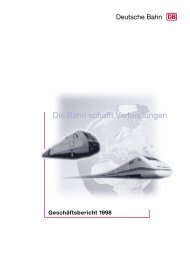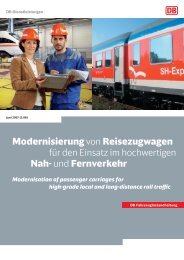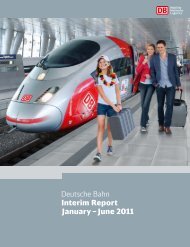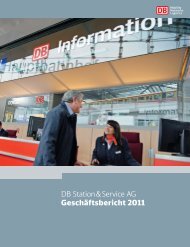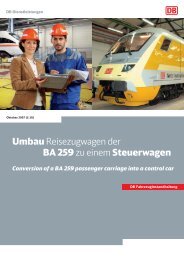PDF Download - Deutsche Bahn AG
PDF Download - Deutsche Bahn AG
PDF Download - Deutsche Bahn AG
Create successful ePaper yourself
Turn your PDF publications into a flip-book with our unique Google optimized e-Paper software.
12 |<br />
DEUTSCHE BAHN <strong>AG</strong><br />
road passenger transport segment continued its downward trend.<br />
Despite the 11 % rise in fuel prices in 2010 and the special boost<br />
resulting from the government’s “cash for clunkers” stimulus<br />
program in 2009, the dominant motorized individual transport<br />
sector was able to retain its previous year’s position, even though<br />
car sales were about 25 % lower. rail was the only mode of trans-<br />
port to expand its intermodal share of market in 2010.<br />
The rail passenger transport segment in Germany was able<br />
to post substantial gains in volume sold over the previous year’s<br />
figure. Driven by a favorable market environment, demand noted<br />
by DB Group companies rose by 2.2 % over the same year-ago<br />
period. This gain was mainly due to the following factors: our<br />
offers and schedule measures were well accepted; the positive<br />
development of our international transports; the restrictions on<br />
air transport due to the outbreak of volcanic ash in the spring of<br />
2010; and the harsh winter weather experienced at the beginning<br />
and the end of the year under review.<br />
We estimate that the performance of non-Group railways<br />
rose by about 5 % due to their taking over additional lines in<br />
regional transport. Their share of the rail passenger transport<br />
market in Germany rose slightly. In total, the rail passenger<br />
transport sector was able to regain the share of market it lost<br />
in 2010 and currently has a market share of just over 10 %.<br />
Volume sold in the public road passenger transport segment<br />
once again declined marginally and was 0.5 % below the previous<br />
year’s level. Despite lower schoolchildren and trainees traffic,<br />
demand for scheduled transport rose due in part to the shift in<br />
transport away from the S-<strong>Bahn</strong> (metro) to bus transport in<br />
Berlin. Total results were, however, dampened by the decline in<br />
non-scheduled transports, which represents about one-third of<br />
volume sold. Volume sold by our bus companies tracked this<br />
overall market development. The many years of decline seen in<br />
the public road passenger transport segment led to a drop of<br />
its share of market to 9.5 %.<br />
Domestic German air transport, which was heavily hit by<br />
the economic and financial crisis in the previous year, benefited<br />
substantially from the economic recovery and recorded a sharp<br />
rise in demand despite the handicaps seen in the first third of<br />
2010 (pilot strike at Lufthansa, volcanic ash clouds and the<br />
unexpected onset of severe winter weather in December). Volume<br />
sold in 2010 rose by 2.2 % while market share remained at the<br />
previous year’s level.<br />
EUROPEAN PASSENGER TRANSPORT MARkET<br />
In addition to the end of government economic stimulus programs<br />
in most countries, the European passenger transport market<br />
was also affected by the tense budgetary situation in Europe.<br />
This increased pressure on the contracting organizations to cut<br />
their costs even further.<br />
In view of the different levels of liberalization within European<br />
countries, certain countries are experiencing increasing<br />
competition while, in contrast, growth is being hindered in other<br />
nations because of unchanging difficult access to their markets.<br />
The market for cross-border transports in Europe tended<br />
to develop hesitantly since it was liberalized in early 2010. This<br />
is mainly due to high access barriers including high investment<br />
levels, state-sponsored protectionism, high fees to access rail<br />
networks, and technical hindrances. Based on our internal<br />
calculations, the overall rail passenger transport market in<br />
Europe in 2010 remained almost at the previous year’s level.<br />
The negative effects of the economic and financial crisis on<br />
the rail passenger transport market were still notably present in<br />
some European countries in 2010. Volume sold by the state-owned<br />
Spanish railway, renfe, declined again by about 3 %. The rate of<br />
unemployment in Spain hit a peak of about 20 % thereby more<br />
than doubling within three years. The situation was different in<br />
Great Britain, the third-largest rail passenger transport market<br />
in Europe after France and Germany. After volume sold in the<br />
UK almost stagnated in the previous year, they rose by a strong<br />
single-digit rate of growth during the year under review despite<br />
a sluggish increase in real incomes and a barely improved situation<br />
in the labor market.<br />
The economic situation in the Netherlands was also marked<br />
by a moderate increase in income levels and even a slight increase<br />
in unemployment compared to the same year-ago figure. Nonetheless,<br />
volume sold within the rail passenger transport sector<br />
rose, which was not lastly due to the start of service on the<br />
high-speed line from Amsterdam to Brussels via rotterdam.<br />
Development noted in the already heavily liberalized rail<br />
markets in Denmark and Sweden posted different results.<br />
Driven in part by greater consumer spending, the Danish<br />
economy grew by about 2 %. The drop in employment slowed<br />
during the year as the unemployment rate fell slightly. Therefore<br />
the rail passenger transport sector was not able to increase<br />
its volume sold in 2010, as the volume sold stayed at the level<br />
of 2009. The Swedish economy posted a broad recovery from<br />
the crisis as GDP rose by 4 % supported by strong contributions<br />
made by consumer and government spending as well as capital<br />
expenditures and foreign trade. Although the economic rebound


